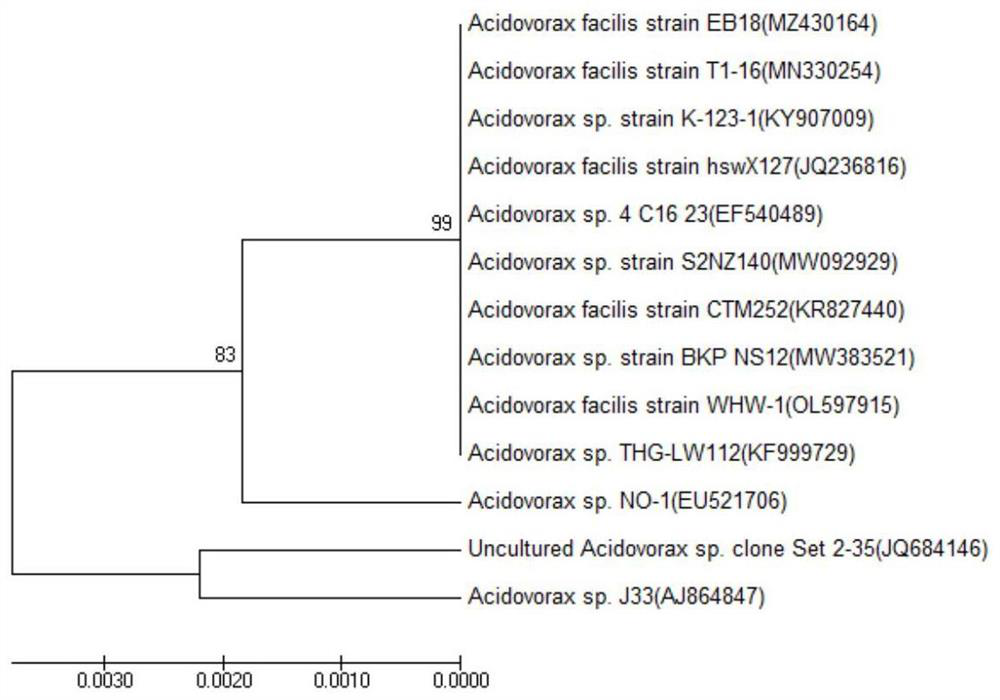Method for repairing arsenic and antibiotic polluted soil through cooperation of bacteria and magnetic diatomite
A technology for polluted soil and diatomite, applied in the field of soil treatment, can solve the problems of long remediation time, secondary pollution, low remediation efficiency, etc., and achieve the effects of short remediation time, large treatment range and low treatment cost
- Summary
- Abstract
- Description
- Claims
- Application Information
AI Technical Summary
Problems solved by technology
Method used
Image
Examples
Embodiment 1
[0034] A method for restoring arsenic and antibiotic-contaminated soil with bacteria and magnetic diatomite comprises the following steps: bacterial strain isolation → strain enrichment culture → preparation of magnetic diatomite material → soil restoration.
[0035] (1) Isolation, domestication and enrichment of bacterial strains:
[0036] The water sample with the mixed microflora was added to the nutrient broth for shaking culture, and after culturing for 72 hours, the bacterial liquid in the nutrient broth medium was transferred to the PYCM medium (the composition of the medium was: 0.8g / L peptone, 0.2g / L yeast extract powder, 0.1g / L dipotassium hydrogen phosphate, 0.2g / L magnesium sulfate, 0.2g / L sodium nitrate, 0.1g / L calcium chloride, 0.1g / L ammonium chloride, 1g / L Ferric ammonium citrate, 0.2g / L manganese sulfate, 0.1g / L ammonium carbonate, pH=7.0±0.2) to continue the culture.
[0037] Gradual dilution: aspirate the bacterial solution in PYCM and press 10 -1 , 10 -2...
Embodiment 2
[0052] The method for remediating arsenic and antibiotic-contaminated soil by bacteria and magnetic diatomite comprises the following steps: bacterial strain isolation and culture → bacterial strain enrichment culture → preparation of magnetic diatomite material → soil remediation.
[0053] (1) Isolation, domestication and enrichment of bacterial strains:
[0054] The obtained strain was inoculated into nutrient broth (17-25g / L) for enrichment culture;
[0055] Specifically, the strain is Acidophilus Swiftlet WHW-1, and the concentration of the nutrient broth is 19 g / L.
[0056] Further, the conditions for the enrichment culture of the strains are as follows: the temperature is at 25° C. and the frequency is 150 rpm for horizontal shaking, and aerobic enrichment culture is carried out for 5 days. During the enrichment culture, the transfer amount of the strain is 5%.
[0057] (2) Preparation of magnetic diatomite
[0058] By FeCl 3 ·6H 2 O: FeSO 4 ·7H 2 The molar ratio o...
Embodiment 3
[0066] The method for remediating arsenic and antibiotic-contaminated soil by bacteria and magnetic diatomite comprises the following steps: bacterial strain isolation and culture → bacterial strain enrichment culture → preparation of magnetic diatomite material → soil remediation. .
[0067] (1) Enrichment of bacterial species:
[0068] The obtained strain was inoculated into nutrient broth (17-25g / L) for enrichment culture;
[0069] Specifically, the strain is Acidophilus Swiftlet WHW-1, and the concentration of the nutrient broth is 19 g / L.
[0070] Further, the conditions for the enrichment culture of the strains are as follows: the temperature is at 25° C., and the frequency is 150 rpm horizontal shaking, aerobic enrichment culture is carried out for 5 days, and the transfer amount of the strain is 5% by volume.
[0071] (2) Preparation of magnetic diatomite
[0072] By FeCl 3 ·6H 2 O: FeSO 4 ·7H 2 The molar ratio of O is 2:1 to weigh FeCl 3 ·6H 2 O(0.1M) solid, ...
PUM
| Property | Measurement | Unit |
|---|---|---|
| Repair efficiency | aaaaa | aaaaa |
| Repair efficiency | aaaaa | aaaaa |
| Repair efficiency | aaaaa | aaaaa |
Abstract
Description
Claims
Application Information
 Login to View More
Login to View More - R&D
- Intellectual Property
- Life Sciences
- Materials
- Tech Scout
- Unparalleled Data Quality
- Higher Quality Content
- 60% Fewer Hallucinations
Browse by: Latest US Patents, China's latest patents, Technical Efficacy Thesaurus, Application Domain, Technology Topic, Popular Technical Reports.
© 2025 PatSnap. All rights reserved.Legal|Privacy policy|Modern Slavery Act Transparency Statement|Sitemap|About US| Contact US: help@patsnap.com



